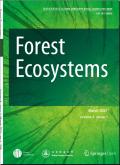基于卫星立体摄影测量和星载激光雷达的最新高分辨率林下地形提取
IF 4.4
1区 农林科学
Q1 FORESTRY
引用次数: 0
摘要
精确的数字地形模型(dtm)对于广泛的地理空间和环境应用至关重要,但它们在森林地区的推导仍然是一个重大挑战。现有的全球dtm通常由卫星立体摄影测量或干涉合成孔径雷达(InSAR)生成,由于穿透能力有限,无法准确捕获林下地形,导致植被密集地区的高程高估。虽然机载光探测和测距(LiDAR)可以提供高精度的dtm,但其有限的空间覆盖和高昂的采集成本阻碍了大规模应用。因此,迫切需要一种可扩展且经济有效的方法来直接从卫星衍生的数字地面模型(DSMs)中提取dtm。在这项研究中,我们提出了一种简单的、可解释的林下地形提取方法,该方法利用全球生态系统动力学调查(GEDI)和冰、云和土地高程卫星-2 (ICESat-2)的冠层高度数据构建树高表面模型,然后从立体衍生的DSM中减去该模型,生成最终的DTM。通过直接结合LiDAR约束,该方法避免了来自多个异构数据集的误差传播,减少了对辅助输入的依赖,确保了易于实现和广泛的适用性。与基于机器学习的地形建模方法(通常容易出现过拟合和数据偏差)相比,所提出的方法简单,可解释,并且在不同的森林景观中具有鲁棒性。根据机载LiDAR参考数据验证了所得DTM的准确性,并与哥白尼数字高程模型(DEM)和森林和建筑物去除高程模型(FABDEM)进行了比较,后者是一种校正了植被偏差的全球裸地高程模型。结果表明,所提出的DTM在精度上优于哥白尼DEM (CopDEM),且精度与FABDEM相当。此外,与FABDEM的30 m分辨率相比,其空间分辨率为1 m,可以更详细地表示地形并更好地捕获精细尺度变化。这种优势在平缓到中等坡度地区最为明显,在这些地区,所提出的DTM显示出明显高于CopDEM和FABDEM的精度。结果证实,利用星载LiDAR约束条件,可以有效地从dsm中提取高分辨率dtm,为无法使用机载LiDAR的森林环境中的地形建模提供了可扩展的解决方案。为了说明所提出的DTM的潜在效用,我们将其应用于基于地形参数(如坡度、坡向和海拔)的火灾风险测绘应用程序。这个案例强调了改进地形表示如何支持地理空间灾害评估。本文章由计算机程序翻译,如有差异,请以英文原文为准。
Up-to-date high-resolution understory terrain extraction based on satellite stereo photogrammetry and spaceborne LiDAR
Accurate digital terrain models (DTMs) are essential for a wide range of geospatial and environmental applications, yet their derivation in forested regions remains a significant challenge. Existing global DTMs, typically generated from satellite stereo photogrammetry or interferometric synthetic aperture radar (InSAR), fail to accurately capture understory terrain due to limited penetration capabilities, resulting in elevation overestimation in densely vegetated areas. While airborne light detection and ranging (LiDAR) can provide high-accuracy DTMs, its limited spatial coverage and high acquisition cost hinder large-scale applications. Thus, there is an urgent need for a scalable and cost-effective approach to extract DTMs directly from satellite-derived digital surface models (DSMs).
In this study, we propose a simple, interpretable understory terrain extraction method that utilizes canopy height data from Global Ecosystem Dynamics Investigation (GEDI) and Ice, Cloud, and Land Elevation Satellite-2 (ICESat-2) to construct a tree height surface model, which is then subtracted from the stereo-derived DSM to generate the final DTM. By directly incorporating LiDAR constraints, the method avoids error propagation from multiple heterogeneous datasets and reduces reliance on ancillary inputs, ensuring ease of implementation and broad applicability. In contrast to machine learning-based terrain modeling methods, which are often prone to overfitting and data bias, the proposed approach is simple, interpretable, and robust across diverse forested landscapes. The accuracy of the resulting DTM was validated against airborne LiDAR reference data and compared with both the Copernicus Digital Elevation Model (DEM) and the forest and buildings removed DEM (FABDEM), a global bare-earth elevation model corrected for vegetation bias. The results indicate that the proposed DTM consistently outperforms the Copernicus DEM (CopDEM) and achieves accuracy comparable to FABDEM. In addition, its finer spatial resolution of 1 m, compared to the 30 m resolution of FABDEM, allows for more detailed terrain representation and better capture of fine-scale variation. This advantage is most pronounced in gently to moderately sloped areas, where the proposed DTM shows clearly higher accuracy than both the CopDEM and FABDEM. The results confirm that high-resolution DTMs can be effectively extracted from DSMs using spaceborne LiDAR constraints, offering a scalable solution for terrain modeling in forested environments where airborne LiDAR is unavailable.
To illustrate the potential utility of the proposed DTM, we applied it to a fire risk mapping application based on topographic parameters such as slope, aspect, and elevation. This case highlights how improved terrain representation can support geospatial hazard assessments.
求助全文
通过发布文献求助,成功后即可免费获取论文全文。
去求助
来源期刊

Forest Ecosystems
Environmental Science-Nature and Landscape Conservation
CiteScore
7.10
自引率
4.90%
发文量
1115
审稿时长
22 days
期刊介绍:
Forest Ecosystems is an open access, peer-reviewed journal publishing scientific communications from any discipline that can provide interesting contributions about the structure and dynamics of "natural" and "domesticated" forest ecosystems, and their services to people. The journal welcomes innovative science as well as application oriented work that will enhance understanding of woody plant communities. Very specific studies are welcome if they are part of a thematic series that provides some holistic perspective that is of general interest.
 求助内容:
求助内容: 应助结果提醒方式:
应助结果提醒方式:


